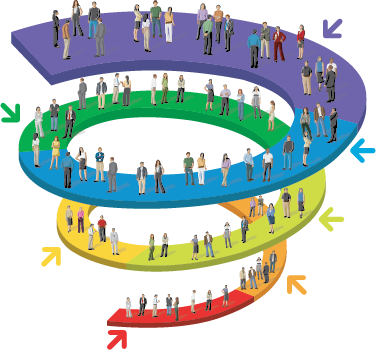
by Francis | Business, Marketing Tips |
 You can save a lot of time, get more clients and run your business more effectively when you use systems for everything you do.
You can save a lot of time, get more clients and run your business more effectively when you use systems for everything you do.
Doing marketing, drawing clients into your pipeline, staying in touch with prospects and clients, scheduling client consultations, converting prospects into clients, keeping records of client communication, billing clients, tracking income and expense etc. etc. are all tasks you do on a regularly (even daily) basis. Creating a system around each of these tasks or activities, makes it easier to do, saves time and can even put your business on autopilot when you are not in the office.
So, what is a system?
Without going too much into details, a system is a set of steps, methods or procedures you follow to carry out a specific activity, perform a task or solve a problem.
Thus, to create a system for a specific activity in your business you’ll need to know all the specific steps you follow – from start to end – to complete that activity.
In practice, creating systems do not need to be complicated. The only requirement is the systems should work best for YOU and YOUR business. Ultimately the purpose of a system is to save you time and to put most of your repetitive tasks on autopilot so they can take care of themselves with no to minimum involvement from you.
Systems save time and put most of your repetitive tasks on autopilot.
Click to Tweet
Here are examples of 5 systems to simplify the process of getting more clients.
Doing Marketing: If networking and frequently attending live events is one of your marketing strategies, a system can simply be to schedule the dates of all the networking events in your calendar. This way you do not have to remember everything as your system will do the work for you. You can even set a reminder for a couple of days before the event to allow for any preparation, if needed. This way you won’t forget about the event and will be well prepared when you attend. Scheduling is a simple system that can help you stay consistent in attending those in-person events, saves time because you know it is scheduled and you’ll be reminded in time, and you’ll feel more confident when you show up, since you had ample time to prepare.
Filling your Client Pipeline: An example of a system to fill your client pipeline is to use your website, email marketing software and a free offer to capture the contact details of visitors to your website. You can direct all your marketing efforts (the people you meet at events, all your off-line and online marketing) to your website and let your well-oiled system takes care of getting these web visitors into your client pipeline so you can stay in touch with them. This is a system that can be set up once. And best of all, it runs on autopilot while you sleep or are miles away on vacation
Staying in touch: It is important to ensure your prospects don’t forget about you. When staying in touch you continuously build relationships with your prospects and keep your services and offerings in front of them. One way to stay in touch is to publish a regular e-zine (electronic newsletter). An example of creating a system around your e-zine is to create a list of topics you want to share with your audience on regular intervals and then to schedule those topics into an editorial calendar of when each will be send out. An important part of this system is also to schedule the time in your calendar to write the content and populate your email marketing system. When you use email marketing software like Aweber, you can write your content in advance and schedule it to go out on a specific date. This saves time and have the added benefit that your communication are send even when you take an extended vacation.
Convert prospects into clients: Once people are interested in working with you, a new client conversion procedure or system can do wonders for your business. An example of a system here is to have a form on your website where prospects can inquire about your services. Once they’ve filled in the form, they receive an automated email to set-up a complimentary discussion where you get together on the phone. For the discussion you can use a specific, pre-developed script or format to lead your prospect from just inquiring about your services to becoming eager and willing to work with you. The system is taking care of all the pre-work and you only have to be there to conduct the discussion and convert the prospect into a new clients.
New Client Intake: When a prospect becomes a client, it is good business practice to give them all the information they need for working effectively with you. An example of a system when a client says “yes” is to have a client information pack (or welcome pack) ready to send to this client. The bulk of this information pack and regular client communications can be pre-developed and only customized per client. This saves a lot of time and prevent you from re-inventing the wheel for each new client.
With workable and automated systems in place, you can simplify and streamline the process of getting clients and accomplish most of your daily client related and administrative tasks in a matter of minutes, not hours.
Systems put time back into your day – time that you can spend on growing your business with clients and income and/or taking a well-deserved break.
Your assignment for today:
- Pick one thing. . . just one thing in your business and create a system around it.
- Start documenting all the steps you take to complete that.
- Evaluate what you can do to automate / facilitate all the repetitive activities to help you save time with this in future.
The ultimate goal is to create systems that don’t require your attention every minute of the day.
To Your Success

P.S. Do you use systems in your business? Tell us about it in the comment box below.

by Francis | Uncategorized
 Earl Nightingale said:
Earl Nightingale said:
“ We are at our very best, and we are happiest, when we are fully engaged in work we enjoy on the journey toward the goal we’ve established for ourselves. It gives meaning to our time off and comfort to our sleep. It makes everything else in life so wonderful, so worthwhile.”
Do you believe that?
I do.
So, my question today is: “What is the ultimate goal you’ve established for yourself. What is it you want to achieve in life? In business?”
You can do it, you know.
The simple truth is: When you set the intention (the goal) both your conscious and subconscious mind start to work on action plans to achieve that goal.They start scanning your immediate environment for ideas, opportunities and tools to help you reach it and they continue with the process until you abandon that goal.
Your responsibility in this whole process is to believe in your goals, believe in yourself, recognize the opportunities that are put in front of you and take the necessary action to make your goal a reality.
I believe setting smart goals for your business is the vehicle to significantly enhance your business results in the next year!! It is how you get everything you want faster than you ever thought possible!
Goals can be used to:
- Increase something – your income, nr of clients, customer satisfaction, effectiveness
- Reduce something – risks, expenses, turnaround times, competition
- Improve something – website, marketing campaigns, business processes, your life
- Save something – time, money, space, energy
There are really many ways on how to set goals, but I personally prefer to set S.M.A.R.T. goals. They are…
- Specific (it is exactly what I want, written in precise detail)
- Measurable (I am able to tell when I reached my goal and how successful I was)
- Achievable (I know I will be able to reach it – even if it has a bit of a stretch)
- Realistic (It is something that can be done – if any other person has done it before, I can do it too)
- Timely (It has a timeline to keep me accountable towards my goals)
So, here’s my quick 6-step process of setting and achieving goals:
STEP 1: Decide exactly what you want
E.g. I wantto increase my income to take my family on a vacation at the end of the year.
STEP 2: Write it down as if it is already a reality. Be specific and give the goal a deadline
E.g. I earn $xx and is taking my family to Disney Land on 30th November 20xx
Now that’s a S.M.A.R.T. goal.
It’s specific (earn $xx). It also includes the motivator why I want to earn this amount (take my family to Disney Land). It’s measurable (I can measure if I actually reached that amount, earned more or less). It’s achievable (when I put my plans in place, I CAN achieve that). It’s realistic (others have achieved that in the past – I can too) and it’s timely (due date 30 November).
STEP 3: Break this goal down in smaller action steps and decide what you need to do / learn / acquire in order to achieve this goal
E.g. To earn $xx by 30th November 20xx, I need to
i. Get a coach to show me the way
ii. Get minimum 5 new clients
iii. Raise my rates to $xx
iv. Learn how to use Facebook Ads to send people to website
Each of these is a sub goal or smaller goal that will help me reach the overall goal of earning enough money to take the family to Disney land. These sub goals can also be broken down into further doable action steps that will make it practically possible to achieve.
STEP 4: Break each sub goal down into doable action steps. Create a plan.
E.g. The sub goal: “Get 5 new clients” in the above example can be broken down into:
a) Create a process for setting up personal discussions with prospects
b) Compile a database or name list of 100 possible people to contact
c) Personally reach out to minimum 10 people on this list each week
d) Convert at least 1 person a week into a new client at new rates
To put these steps into action, simply plan and schedule time in your calendar to do it.
STEP 5: Identify the people whose help and cooperation you’ll require to achieve your goal.
E.g. in our above example: Who already has a list of people you can partner with? Who is the coach that can help show you the way? Do you already know someone or do you need to do some research. Who can help you with making the decision?
To achieve big goals you will have to have the help and support of lots of people. One key person at a certain time and place in your life will make all the difference. So think about who are those key people that can help you and who you can help in return.
STEP 6: Share your goals.
One of the most effective ways to achieve a goal is to share it. When you tell others about the goal, it subconsciously motivates you to take the necessary action to achieve it. Plus, you’ll have a group of people who can help you stay accountable to do the things you want to do. It really works!
To Your Success


by Francis | Marketing Planning
 Is marketing one of those things that you know you should do, but you just never get to do it properly? Mostly because there are so many other things that take up your time?
Is marketing one of those things that you know you should do, but you just never get to do it properly? Mostly because there are so many other things that take up your time?
What? Did I hear you say….”yes”!
Well, don’t feel too bad about it. For most solo-preneurs, this is a common problem.
We have to wear so many different hats in our businesses and have to do everything ourselves that it is easy to put marketing on the back burner and only focus on it once everything else (like doing your admin, cleaning your office or walking the dog) is taken care off.
And common reasons for this are that for many, marketing is not the most enjoyable activity. They even intensely dislike it. Or they don’t know where to start with it.
This is perhaps an over exaggeration, but the fact of the matter is, it often happens that we don’t give marketing and getting clients the attention it need.
And when you put marketing on the back burner and only focus on it once in a while (when all the other fires are put out), you never really get to do it properly. The scary thing is: if you don’t do your marketing consistently you don’t have clients consistently…. which ultimately results in uneven income or no income at all
Here are 5 things you can do to make marketing a priority in your business this year:
1. Plan your marketing activities
Pull out your calendar and write down a number of ideas how you’ll market you business each month of the year. Look for things like special vacation days – e.g Valentines Day, St Patrick’s Day or Thanksgiving and plan special marketing activities around those days. Write down events that you know are taking place and brainstorm how you can use those events to market your business. The thing is: even a rough plan is better than no plan. Just have something on paper that you can refer to frequently and that will keep you on track.
2. Pick marketing strategies that fit the goals of your business
Don’t do marketing just for the sake of marketing. To make your efforts hit the mark, pick marketing strategies that will reach your ideal clients effectively. In other words: go where your clients are! If you for example know your ideal clients are international speakers, it won’t help much putting an advertisement of your services in your local newspaper.
3. Create a frequent and regular communications campaign
A simple rule of marketing success is that it’s necessary to stay in touch with clients and prospects on a regular basis or else they forget who you are and what makes your services so wonderful. So stay in touch with regular communications: create an email newsletter filled with helpful info and send it out regularly; send unexpected greeting cards for birthdays, Valentine’s day, Easter or Christmas; send a small gift; pick up the phone and call clients to ask how they’re doing. Staying in touch does not need to be expensive. A little bit of creativity, can take you a long way.
4. Make time for marketing daily
Block out chunks of time in your calendar daily where you do nothing else than marketing. It will take a bit of self-discipline to stick to these time-slots in the beginning, but in the end it will bear fruit. Here are some things you can do every day, to market and grow your business: Follow up with a potential client who showed interest in working with you; send an introduction email to potential clients; attend a networking event (online or offline); create a blog and write a new blog post; post your article on social media sites and invite people back to your website; create a Facebook ad; call a past client and ask for a referral. Marketing doesn’t have to be complicated. Just make a commitment and do it.
5. Persevere and be consistent in your marketing efforts
It won’t help much to crank out a few marketing activities only when the appointment book looks a bit empty. Marketing is a process – it rarely creates instant results. The marketing activities you do today will bring in clients in future. So do your marketing every day. Persevere and you’ll fill your business with clients faster than you thought possible.
Remember, your clients need your help. They’re stuck and are searching for someone to help them solve their problems and frustrations. That someone is you! It is your duty to help them take the first step to get unstuck…. that’s what your marketing is all about. So, make marketing a priority in your business this year
To Your Success


by Francis | Attracting Clients, Business, Marketing Tips
 If you’ve been in business for a while, you would have heard from more than one marketing expert that knowing your target audience and clients REALLY well, is the beginning of a positive upward spiral for attracting more clients to your business.
If you’ve been in business for a while, you would have heard from more than one marketing expert that knowing your target audience and clients REALLY well, is the beginning of a positive upward spiral for attracting more clients to your business.
This speaks for itself, because the better you know your clients, the better you can tailor your marketing message to solve their biggest problems, the better they’ll relate to your message – making it easier for you to attract them and convert them into paying clients.
Thus, knowing your clients is critical to your business success….and it starts with your ability to put yourself in your clients’ shoes – to truly understand who they are and what they need.
So, here are 8 important things to know about your clients that will put your business and client attraction on an upward success spiral.
1) Who are they?
Everyone talks about the importance of defining a target audience and ideal client…yet very few businesses actually do it. However, the clearer you are about who you work with, the easier it will be to get to know them AND to identify places to find them.
2) Where do they spend their time?
Knowing where they spend their time, helps you to also be present – either in person or via your marketing materials.
3) What do they struggle with?
Every business has a number of frustrations and struggles that they want to get rid of. What are those struggles for your clients as it pertains to what you do? Knowing what they struggle with can help you position your business to become their problem solver.
4) Why are they struggling with it?
There is always a reason why people struggle with something. E.g. do they have these struggles due to time constraints or lack of specific knowledge and skills or lack of technology and equipment? Finding the reasons can help you tailor your services and marketing to solve those problems.
5) Why would they work with you?
Do you stand out from your competitors? What will be the deciding factor to help your clients decide that you are the one to work with?
6) Why do they need your services?
Understanding why a client needs your services means that you can approach him at the right moment when he is ready to work with you. E.g. if you provide financial tax support, you can start promoting your tax related expertise during the start of tax season, increasing the likelihood of attracting clients searching for tax help and advice, because they might not feel confident enough to do it themselves or they want to save time.
7) What do they expect when working with you?
Understanding client expectations means you can encourage a positive customer experience from the start and maximize the chance of repeat business. E.g.when you know what they expect, you can bring that into your very first client conversation to put them at ease about working with you. Then ensure you do that to retain their business.
8) What are their top 3-5 priorities / goals?
The more information you have on what your clients’ top priorities are, the better you can position your marketing and your services to assist them reaching those goals faster.
Knowing your clients is a powerful way to propel your business forward. It allows you to make positive changes in your own business to accommodate their unique and varied needs. This helps you stand out and makes you much more client attractive.
To Your Success


by Francis | Uncategorized
 “Where to find clients” is one of the most frequently asked questions I receive from my subscribers and rightly so. Because knowing where you can find your clients will make marketing and getting paying clients much easier.
“Where to find clients” is one of the most frequently asked questions I receive from my subscribers and rightly so. Because knowing where you can find your clients will make marketing and getting paying clients much easier.
So here are 4 practical things you can do to find more clients.
1. Get really clear on WHO you want to find.
The first and most important thing to do, is to get really clear on your target audience. Who are those people you want to attract to your business and what are the common characteristics they have.
Get a clear picture of them in your mind and think about things like:
- Their geographical location, profession, gender, age, income levels
- Their hobbies. What do they like to do?
- What magazines or blogs do they read?
- What events do they attend?
- What problems do they struggle with?
When you are really clear who this ideal client is, everything else will stem from that, because this knowledge already gives you a pretty good idea where to go look for those clients.
2. Be present in places your clients spend their time
The 2nd or next thing to do is to think about where do these people spend their time. Where do your ideal clients hang out? Can you find them at specific networking events or even special live events like tradeshows or conferences? Can you find them online?
You want to look at places where you will be able to find them in larger numbers, because when you find your ideal clients in larger numbers, it makes marketing easier and more cost effective.
A great place to start is for example social media. With the number of people who spend time on social media, you will most probably be able to find your audience there as well. But you don’t just want to fire away and get involved in all social media platforms. Rather think about where those clients you want to find, will most LIKELY spend their time. Will your audience spend time on Facebook or will you rather find them on LinkedIn, Twitter or perhaps Pinterest – e.g. moms working from home, might be more inclined to spend time on Facebook; people with professional careers, might be more inclined to spend time on LinkedIn.
Again, clarity about your target audience will give the answers on where they will most likely spend time so you can be present there as well and have a higher probability of getting your business in front of them.
3. Find others who are already talking to your ideal clients
Start looking for people who are already talking to your ideal clients (online or offline) or someone who already have a list of these people. Think about organizations your ideal clients belong to. Think about possible collaboration partners who are already sending information or even a newsletter to your ideal audience on a regular basis.
When you’ve identified these possible partners, reach out and connect with them. Offer to provide some value to their audience so you can invite them into your business.
4. Talk to current clients and people in your immediate environment.
One of the easiest ways to find new clients is to ask current clients and people in your immediate environment if they know about someone who fits your ideal client profile and who might benefit from what you offer. This way, you can get a number of referrals to personally follow up with.
So, those are some great ways to find new clients. All that is left now, is to put it into action and go get your clients.
I’d love to hear your comments, so please leave a comment below and tell us which one you’ll take action on first.
To your Success


 You can save a lot of time, get more clients and run your business more effectively when you use systems for everything you do.
You can save a lot of time, get more clients and run your business more effectively when you use systems for everything you do.








